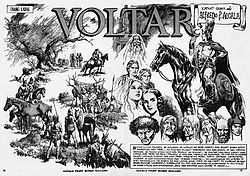Voltar (comics)
| Voltar | |
|---|---|
 Illustration for first release in the Philippines, 1963. | |
| Publication information | |
| Publisher | Craf Publications (Philippines), Marvel Comics (USA) |
| Genre | see below |
| Publication date | 1963 (Philippines), 1977 (USA) |
| Main character(s) | Voltar |
| Creative team | |
| Creator(s) | Alfredo Alcala |
Voltar was a comic strip title and comic book character created, written, and illustrated by Filipino illustrator Alfredo Alcala in 1963.[1] A story about Vikings, Voltar was first published in the Philippines by CRAF Publications, a comic book company established by Alcala himself, together with other colleagues in the field of comics such as Virgilio Redondo, Nestor Redondo, Amado Castrillo, and Tony Caravana, among others. Voltar was described as one of the most spectacular comic strips to ever appear in Philippine comics.[2]
Although the inspiration for Voltar, as a Viking saga[3] and as a tale about a "barbarian hero",[4] was the Conan the Barbarian novels written by Robert E. Howard,[4] the style of the illustrations was described by G.W. Thomas as "brilliant for 1963" because it was done seven years before any actual illustration of Conan the Barbarian as a character in comics existed.[1] Voltar was first published in the United States by debuting in Magic Carpet #1 (1977)[5] and then in the comic book The Rook #3-9, after Alcala drew artworks for Marvel Comics, particularly the The Savage Sword of Conan.[1] Voltar was later published also by Marvel Comics during the 1970s.[4] It was reprinted in The Rook from June 1980 to June 1981.[1]
Description
The Comics Reporter described Voltar as "an incredibly lavish, lushly-drawn comic book serial that showcased Alcala's diverse interests and influences".[6] According to Orvy Jundis, a scholar in the field of comics, described Voltar in the World Encyclopedia of Comics, as "truly unique" because "it was a continuing series geared towards mass readership. It was written, laid-out, penciled, inked, lettered and published by one man, Alfredo P. Alcala. The brush used to ink many Voltar pages was a special fountain-brush invented by Alcala, thus making the series even more noteworthy."[7] Jundis declared Voltar as "one of the earliest epic comic book series to result from a single creator's vision".[6] Voltar was further regarded by the World Encyclopedia of Comics as "an antonishing display of sustained artistic endeavor" because "[e]very chapter contains a spectacular center spread. Each panel is embellished in an etching style that rivals the works of the old masters. Inch for inch, it is probably the most detailed art ever to appear in comic books."[2]
Awards and recognition
In the Philippines, Alcala obtained awards for Voltar from the Society of Philippine Illustrators and Cartoonists. In the United States, Voltar won for Alcala awards in the field of fantasy and science-fiction during the 1970s. An illustration of Voltar, which was a part of a fantasy and science-fiction exhibition in the United States, became the first prize winner for a heroic fantasy competition in 1971. In 1974, it was featured in the book entitled The Hannes Book Memorial Showcase of Fantasy Art, a compilation of several of the finest artworks in the fantasy genre.[7]
See also

References
- ↑ 1.0 1.1 1.2 1.3 "Voltar" (Alcala Komiks Magazine) (1963)
- ↑ 2.0 2.1 '"Voltar", a Viking saga', Alfredo P. Alcala by Komiklopedia on 2007/10/02
- ↑ Voltar, a Viking saga, ALFREDO ALCALA
- ↑ 4.0 4.1 4.2 Voltar, a Viking saga, Alfredo Alcala
- ↑ Per Arndt, "The Warren Magazines", artist "[Alfredo] Alcala's Voltar character had been invented in The Philippines back in the 1960s.... He debuted in America in Magic Carpet #1 (1977) with scripting by Manuel Auad."
- ↑ 6.0 6.1 "Voltar", Obituary: Alfredo Alcala, 1925-2000, May 30, 2000
- ↑ 7.0 7.1 Voltar, Alfredo Alcala
External links
- Alfredo Alcala's Voltar, Pilipino Komiks, 25 March 2006
- Sample illustration of Voltar, VOLTAR, Alcala Fight Komiks #23, May 26, 1964, Craf Publications
- Magic Carpet's cover for Voltar circa 1977, Alcala Legacy Milestone of the Master